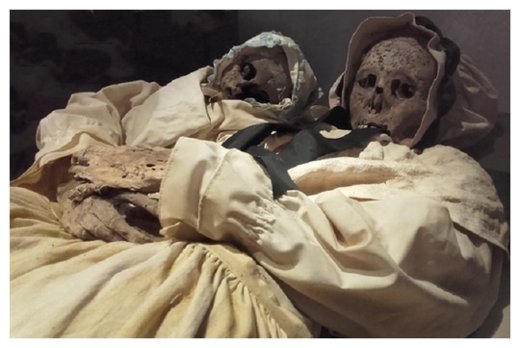
© Rossella LorenziThe mummified remains are part of an exhibition in Hildesheim.
By analyzing 18th century mummified remains, Hungarian researchers have
found the first direct evidence of a C-section performed on a deceased mother.The procedure was widely performed in the 18th century on dead mothers in order to attempt baptize the baby while still alive."Caesarean section was made exclusively on women who had died in childbirth," Ildikó Szikossy, an anthropologist and senior curator at the Department of Anthropology at the Hungarian Natural History Museum in Budapest, told Discovery News.
"Indeed, alive patients could have not survived the operation at that time."
"In most cases the baby too died shortly after receiving the sacrament," she added.
Szikossy and colleagues found traces of a sharp-edged 5.7 inch long cut, running from the umbilical ring to the pubic symphysis, in one of the 265 natural mummified bodies kept at the Natural History Museum in Budapest.
The mummies were uncovered in 1994-1995 from a long forgotten crypt in the Dominican church of Vác, a town 22 miles north of the capital on the eastern bank of the Danube river.
"The coffins were beautiful decorated and contain the name, age and age of death of each individual," Szikossy said.
She presented her findings at the International Conference of Comparative Mummy Studies in Hildesheim, Germany. Szikossy and colleagues explained that the mummified remains of a young woman buried with her baby are so far the only evidence for a procedure widely performed in the 18th century.
"Legal regulations appeared in Hungary already at the end of the 16th century to make after-death intervention obligatory," Szikossy said. Also the Church urged the removal of the fetus to save the soul of the baby, if still alive." While the name on the coffin revealed the young woman was Terézia Borsodi, the death registry, written in Latin, provided more details.
Dated Dec. 9, 1794, it explained that Borsodi was the wife of postmaster John Weiskopf and died in childbirth at the age of 26 with her son, "who was delivered by Caesarean section alive and baptized while still alive."
In addition to the recorded history of the young woman, the researchers found other physical proof that Borsodi was dead at the time of the C-section.
"The bad quality of the sewing is enough evidence that the mother had already died when the procedure was made," Szikossy said.
The researchers determined the fetus, a male, was 38 to 39 weeks old.
"The baby was mature and normal sized. That was the sixth birth for Terézia (Borsodi)," Szikossy said.
She speculated the birth went wrong because the baby was probably in abnormal position.
"She must have suffered a long, painful labor before dying," she added.
The following day, mother and son were buried together.
Their mummified remains are now part of the exhibition "Mummies of the World" at the Roemer und Pelizaeus Museum in Hildesheim.

Reader Comments
to our Newsletter